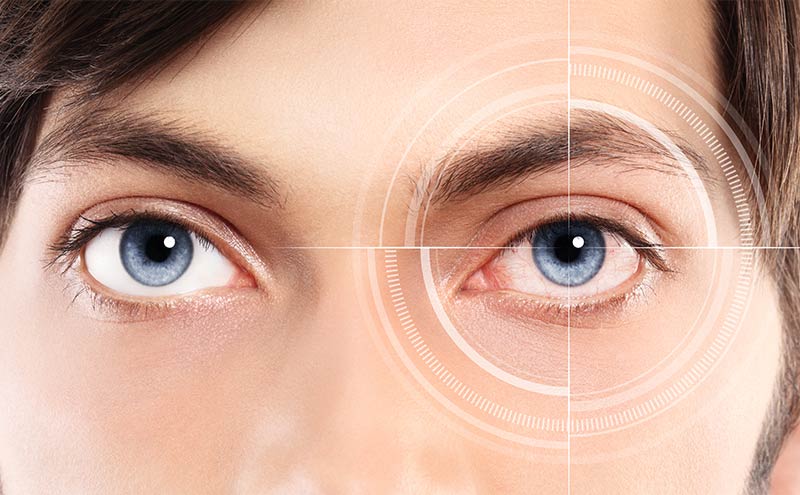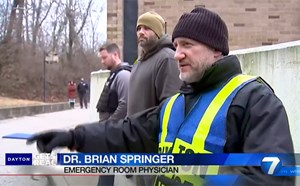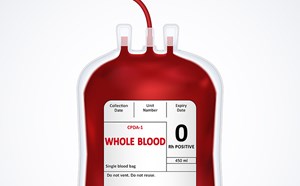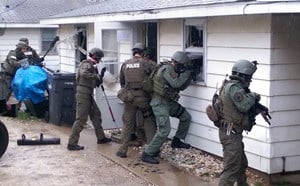
Featured Article: Law Enforcement Laser Eye Injuries - Prevention, Diagnosis, and Management
Laser eye injuries to tactical officers and other law enforcement personnel is an increasing threat. The definition of a laser is this: a device that emits light through a process of optical amplification based on the stimulated emission of electromagnetic radiation. The term "laser" originated as an acronym for "light amplification by stimulated emission of radiation". As laser technology becomes more advanced and more easily obtained by the general public, it has the potential for illegal use that may result in irreversible eye damage and career-ending loss of vision. It is important for all patrol officers and deputies, civil disturbance / mobile field force teams, tactical officers, tactical medicine providers and administrators to be well-informed about how to recognize, prevent, treat, and manage laser eye injuries. The following article is a summary of the presentation by Dr. John Wipfler at the 2020 ACEP Annual Tactical Emergency Medicine Section Meeting.
Lasers are used in a variety of industries and many military and civilian applications. The use of lasers in law enforcement is well-established, as well as their medical use in diagnosis and treatment. Armed forces worldwide have increasingly been using lasers, and normal day-to-day businesses applications include barcode scanners, entertainment, CDs, DVD's, holograms, alignment of car tires, lecture presentations, and many other uses; as with any technology or tool, it can be misused. Over the past several years law enforcement personnel have witnessed an increase in community civil disturbances worldwide. In locations where demonstrators have gathered, lasers have been used as signaling devices to catch the attention of the public. However, they are increasingly being aimed directly into the eyes of law enforcement professionals and other public safety personnel at the scene, with the intent to cause harm. The threat of powerful lasers is a significant issue, and it is important for LEOs and tactical emergency medical support personnel to be aware of the prevention methods, diagnostic testing, and management needed for those who may be exposed to laser radiation. International laser sales and internet sales of laser devices is poorly regulated, and it is possible for very powerful lasers to be bought by anyone and used with criminal intent.
Why do demonstrators and others use lasers?
Lasers may be used to gain attention for the protest; they may be used to express displeasure at the events; they may be aimed at camera sensors to limit or shut down facial recognition systems. They also may be aimed at authorities to distract or temporarily flash blind them, and some criminals will purposefully target LEOs or soldiers with a goal of inflicting pain and eye or skin injuries.
Anyone studying lasers and eye injuries should review the Retinal Hazard Region of the laser light spectrum, and be familiar with the types of lasers that their personnel and teams may face. The Retinal Hazard Region ranges from 400 nanometers (nM) to 1400 nanometers wavelength. The following facts are important to remember for TMPs:
Lasers
- 400 nm to 760 nm are recognized as visible light
- 400 nm to 1400 nm = can cause damage to the retina “retinal hazard region”
- Blue laser = 445 - 480 nm
- Green laser = 520 nm
- UV (290-400 nm) and far Infrared (1400-10,600 nm) can cause damage to cornea and lens (human eyes cannot see these wavelengths = dangerous). These types of lasers are very rare and the average citizen will likely not obtain nor use these.
- Vision loss is greater at the fovea (focusing area on retina)
There are two key concepts that should be taken into consideration regarding exposure to lasers:
- MPE = Maximal Permissible Exposure - maximum laser exposure that will not cause biological changes to the eye
- NHZ = Nominal Hazard Zone - area where protective goggles must be used, as the radiation from the laser source exceeds the MPE.
Classes of Laser
Lasers are categorized into several classes depending on their power and ability to cause eye damage. Class 2 laser sources are familiar to most of us, and include the simple 1 milliwatt (1mW) red pointer used for presentations. The maximum power that should be used by civilians is a 5 mW green or red laser. These are Class 3R, and direct eye exposure should be avoided. The next higher Class is 3B which includes 25 through 250 mW green hand-held lasers. Class 4 lasers include lasers above 500 mW of power, include green or blue (445 nm) wavelengths, and may cause severe eye or skin damage from direct or scattered radiation. For approximately 120 US dollars, a 3500 mW laser can be bought on eBay and other internet sources. These lasers can light a match from several inches away in under 2 seconds, and can burn a hole through newspaper in less than 3 seconds. They are capable of causing significant eye injuries, and prolonged exposure can easily cause superficial skin burns and other injuries.
How do lasers cause damage to the eyes?
Damage is due to the following effects:
- Photothermal effects: thermal change of the tissue of 22 degrees Fahrenheit (or more) will result in tissue damage to the retina and other eye tissue
- Photomechanical effects: optical tissue damage, local vaporization of tissue, hemorrhage, and other cellular damage
- Photochemical processes: photons from the laser beam can interact with eye tissue cells and damage results.
Damage to the eyes from laser radiation is dependent upon the duration, dose, distance, and other factors. Prolonged exposure, more powerful wavelengths, and closer proximity result in greater energy transfer and eye damage.
The laser impact location on the human eyeball is important. The fovea is a particularly bad area for the beam to strike, as this is where most of our visual acuity is concentrated. The laser may result in tissue distortion, hemorrhage, and swelling which all compromise vision.
If there is a cataract present in the eyeball lens, it may actually help protect from retinal damage; however, it may increase heat absorption and worsen damage to the lens. The structural integrity of adjacent tissue is important, and if significant damage occurs, then swelling, bleeding, and vascular compromise will result. The sclera and cornea may be injured depending on the amount of laser radiation.
Enhancement by reflective media (such as nearby mirrors) may increase tissue damage, and if the eye pupil diameter is larger, such as during night-time operations, it may allow more laser light to strike the retina and worsen the damage. Retinal pigmentation is a factor, and darker sections of the retina may absorb more energy and increase damage. A green laser of approximate wavelength of 530 nanometers can significantly damage dark-adapted eyes.
Symptoms
The presenting features of laser eye exposure range from asymptomatic, to minor flashing bright color or flair, to long-lasting visual defects (bright or dark or colored spot ‘seen’ by the affected eye. There may also be a temporary or permanent afterimage, or flash blindness (for example a green laser may cause persistent red color visual effect after exposure). More significant exposures may cause eye pain and blepharospasm. Rubbing of the eyes may occur, and some may develop corneal abrasion-type injuries more likely from eye-rubbing than from direct laser injury. Other signs and symptoms include visual field defects, headache, nausea, and partial or complete blindness. Note that blindness or serious visual field defects are unusual, and prolonged pain (within several hours of exposure) rarely occurs. If pain persists, further investigation for other sources is recommended.
Assessment of Laser Eye Injuries
Any individual who is thought to have sustained a significant laser exposure to their eye should be sent to an ophthalmologist with experience in managing eye laser injuries. Special testing and evaluation will need to be performed, which requires specific equipment and diagnostic techniques in order to accurately diagnose and treat laser injuries. Significant retinal laser injuries require assessment ophthalmoscopically and angiographically.
There are three testing modalities that may be utilized in order to assess the seriousness of the laser injury:
- fundus photography
- fluorescein angiography
- optical coherence tomography
The results of these tests and possibly other medical testing may be used to help diagnose and determine appropriate management. Due to the rarity of these types of injuries, rural officers and public safety personnel should consider traveling to a larger city where more experienced ophthalmologists can guide care.
Treatment of Laser Eye Injuries
There is very limited research on ideal treatment for laser eye injuries. The most experienced ophthalmologists should be sought for evaluation and treatment. There is no standardized approach at this time. There is some evidence that oral or intravenous steroids may be beneficial, and in some situations (hemorrhage, significant eye tissue disruption) the use of YAG laser treatment to minimize nearby additional hemorrhage and retinal detachment may be worthwhile. Patients who develop visual impairment with significant scarring or hemorrhage may respond to surgery (to remove scar tissue, blood, and debris).
What can law enforcement officers do to protect themselves against laser attacks?
When exposure is apparent, simply blinking the eyelids closed or looking down and looking away from the laser source can prevent injury. Protective equipment that can be obtained includes laser-protective eyewear such as anti-laser goggles. There are also laser shield strips that can be applied to the top of a clear helmet face shield. They help absorb laser beams when the wearer tilts their head downward so the beam strikes the protective strip. Additional factors that can be used to stop or minimize laser use includes educating the public about the hazards and laws against use of lasers, as well as identifying and stopping the suspects who are using lasers illegally. Making the public aware of the risk of criminal prosecution may help decrease unauthorized use of lasers.
Protective Eyewear
Protective eyewear is critical for LEOs who deploy to civil disturbances or other location where lasers may be used. Special laser goggles exist that will absorb the laser beam energy and prevent or decrease the amount of damage to the human eye. These are made out of a polymer plastic / polycarbonate or silicone dioxide (glass) that has properties that absorb the laser energy and diffuse it elsewhere as heat and light.
What eye protection is recommended for LEOs and Tactical Medicine Providers?
Current price ranges for protective eye goggles range from 9 to over 300 US dollars.
It is important for all TMPs / LEOs to carefully research, evaluate and choose the optimal protective eyewear for their region and threats. Ongoing research and testing are important, and with time better protective goggles and other solutions will be developed.
What are important considerations when choosing laser safety eyewear?
- Determine what your laser threat is likely to be.
- Determine OD (optical density) of the laser safety glasses needed, based on those threats.
- Glass versus polycarbonate lenses: For public safety, the glass poses additional risks, but may be necessary depending on the laser threat wavelength. Polycarbonate laser safety lenses may also be good at protecting the eyes from shrapnel and ballistic threats, but should be tested / verified.
- Frames – choose appropriate for your mission / deployment.
- Day versus night mission – choose eyewear that will not darken your vision excessively in a low-light or night operational deployment\
- Consider the cost of the equipment and who is paying. Individuals or agency?
- Availability? Can you obtain them in time for deployment when your team is activated?
(Note from author: Financial Disclosure: none - These are the personal recommendations by the author who investigated multiple types of goggles, and has no financial involvement in any of these companies)
As of December 2020, the most ideal solution found by Dr. Wipfler was the Eagle Pair ® with protective range of 190 - 540 nm, OD6 Standard Safety Goggle, which could be obtained from survivallaser.com and other sources for a cost of approximately 45 US dollars plus S+H. They stop a majority of the 10 mW through 3500 mW blue and green lasers favored by rioters / demonstrators in the US and elsewhere. In addition, in the author’s personal tests of ballistic protection, they stopped lead pellets (size 7.5) from a 12-gauge shotgun fired at 25 yards at a speed of 1350 feet per second. They also did not significantly impair low-light visual capabilities. Note that 9-dollar inexpensive orange-colored laser glasses purchased on the internet did not perform nearly as well as the above eyewear.
Note: all LEOs / tactical officers / TMPs should conduct their own up-to-date evaluation of laser protective eyewear and choose those cost-effective devices that have been shown to work effectively against the local laser threats. Do not buy the 9-dollar goggles from eBay!
Summary
Hopefully this article has shed some light (no pun intended) on the importance of preventing, identifying, and managing laser eye injuries.
The key points to remember:
- Lasers are a growing hazard to peace officers and others.
- LEOs and tactical medicine providers need to be prepared when dealing with demonstrators / riots.
- Obtain and use eye protective devices that block or minimize laser beam exposure.
- Fortunately, serious injuries are rare. This may change.
- Expert evaluation should be sought, especially if any visual changes are noted or suspected.
- Steroids, surgery, other options may be utilized for treatment. No standards exist yet.
Educate your LEO and EMS brothers and sisters and prepare. They should be ready to step in and stop the use of lasers at civil disturbances immediately.
For those interested, the Laser Eye Injury lecture is available on the ACEP Tactical Emergency Medicine website in the ‘members-only’ section. Also available for download is a short MP4 video on the effects of lasers (3500 mW blue laser tested)
Thank you. Stay safe and ready. JW
Bibliography
- Eye injuries from laser exposure: a review.
Hudson SJ.Aviat Space Environ Med. 1998 May;69(5):519-24.PMID: 9591626 - Assessment of alleged retinal laser injuries.
Mainster MA, Stuck BE, Brown J Jr.Arch Ophthalmol. 2004 Aug;122(8):1210-7. doi: 10.1001/archopht.122.8.1210.PMID: 15302664 - Risks of occupational exposure to optical radiation.
Sliney DH.Med Lav. 2006 Mar-Apr;97(2):215-20.PMID: 17017352 Review. - Shedding some light on laser pointer eye injuries.
Ajudua S, Mello MJ.Pediatr Emerg Care. 2007 Sep;23(9):669-72. doi: 10.1097/PEC.0b013e31814b2dc4.PMID: 17876263 Review.
John Wipfler, MD, FACEP, RDMS
Chair, Section of Tactical Emergency Medicine, American College of Emergency Physicians
Co-chair, TEMS Committee, Illinois Tactical Officers Association
Professor of Emergency Medicine, University of Illinois College of Medicine
Tactical Physician and Medical Director, STATT / WCSO TEMS Unit
Major (ret) U.S. Army Medical Corps (Res)



